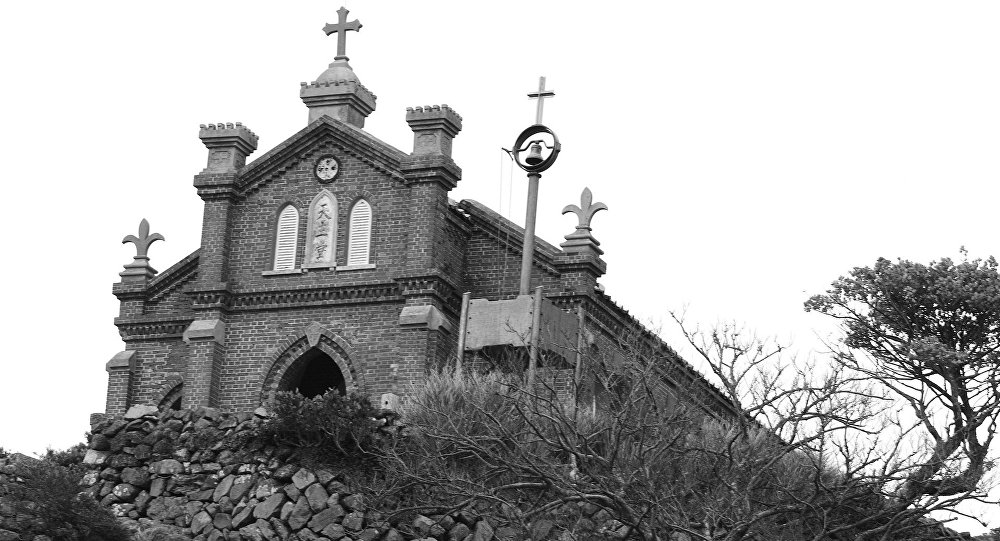
Images Capture the Spirit of Japanese Island Once Home to ‘Hidden Christians’

© PHOTO: MAKIKOPHOTO.COM
It has been abandoned ever since and the island’s main occupants now are a herd of 400 wild Japanese deer.

© PHOTO: MAKIKOPHOTO.COM
Nozaki is one of 17 volcanic islands off the north-west coast of Japan. The wind blows in off the Sea of Japan, stunting and shaping the trees
Sputinknews – 4/5/17
A photographer who specializes in black and white images has captured the spirit of an island off the west coast of Japan, which was once the home of persecuted Christians, but has now been abandoned.
In the 19th century, the island of Nozaki off the west coast of Japan was home to a few hundred Japanese Roman Catholics who were persecuted by the Tokugawa shogunate.
The shogun — military dictator — banned Christianity after the Shimabara Rebellion of 1638, which he blamed on Catholics stirring up the peasantry.
Those who refused to give up their religion were known as Kakure Kirishitan or Hidden Christians. Many of them built private rooms in their houses where they could worship god in secret.
Come and feel the virtual wild forest at #trailstoprayer exhibition at @LSEpublicevents@MAKIKOPHOTO pic.twitter.com/LsbZjWpyFx
— MAKIKO (@MAKIKOPHOTO) April 25, 2017
Later some fled the mainland and ended up living as virtual hermits on Nozaki — in two settlements, Nokubi and Funamori.
Martin Scorsese’s acclaimed 2016 film Silence, starring Andrew Garfield and Adam Driver, was set in the same era. Garfield and Driver play two Jesuit priests searching remote parts of Japan for their missing mentor.
The ban on Christianity was only finally dropped in Japan in 1873 after the Emperor was restored to the throne.
Eight years later, a church was built at Nokubi to cater for the 18 Christian families who remained. It still stands as if time has stopped and there have been efforts to get it added to the UNESCO list of World Heritage Sites.
At one time there were 600 people living on Nozaki. Most lived in grinding poverty, trying to scratch out an existence on the infertile soil.
The last resident left the island in 2001 — he was ironically a Shinto priest.
Last year photographer Makiko visited the island and took a series of dramatic monochrome images which she is currently displaying in London in an exhibition entitled, Trails to Prayer — a spiritual journey to the uninhabited island of Nozaki.
“People have been living there for 10,000 years but the last one left in 2001,” Makiko told Sputnik.
The island has a steep mountainous character, there are rare species of butterfly, wild woods around the Okino-Kojima shrine and hundreds of Japanese wood pigeons, which are protected under Japanese law.
“It looks like a savannah, it doesn’t look like Japan at all. I wandered around entirely on my own, just me and nature. It was priceless. There were strange-shaped trees and a lot of deer,” Makiko said.
Makiko’s decision to focus on Nozaki followed her earlier exhibition, Paradise Revisited, which centred on Hashima island, which is a few miles away.
Hashima is better known as Battleship Island (Gunkanjima) and featured in the 2012 James Bond film Skyfall.
An entire concrete town was built around the island’s coal mines by the giant Mitsubishi corporation and at one point more than 5,000 people were living there. But the coal was exhausted by 1974 and the last remaining residents moved away, leaving a bizarre ghost town.
She is bringing the Paradise Revisited exhibition to Tokyo and Fukuoka later this year and is also in the process of publishing a coffee table book about the island.
© Photo: makikophoto.com


132764 278274I appreciate your function , thanks for all the informative weblog posts. 437421